Business Finance: Rio Tinto's Financial Analysis, Ratios & Capital
VerifiedAdded on 2023/04/03
|15
|2866
|92
Report
AI Summary
This report conducts a financial analysis of Rio Tinto Mining Company, evaluating its operations and financing activities. It examines key financial ratios, including profitability and operating efficiency, and determines the cost of capital by analyzing the company's finance sources. The cost of equity is calculated using the Gordon growth model. Additionally, the report compares the company's share price over two years with the All-Ordinary Index. The analysis indicates that Rio Tinto's financial performance is improving, with increasing profitability and better resource management.
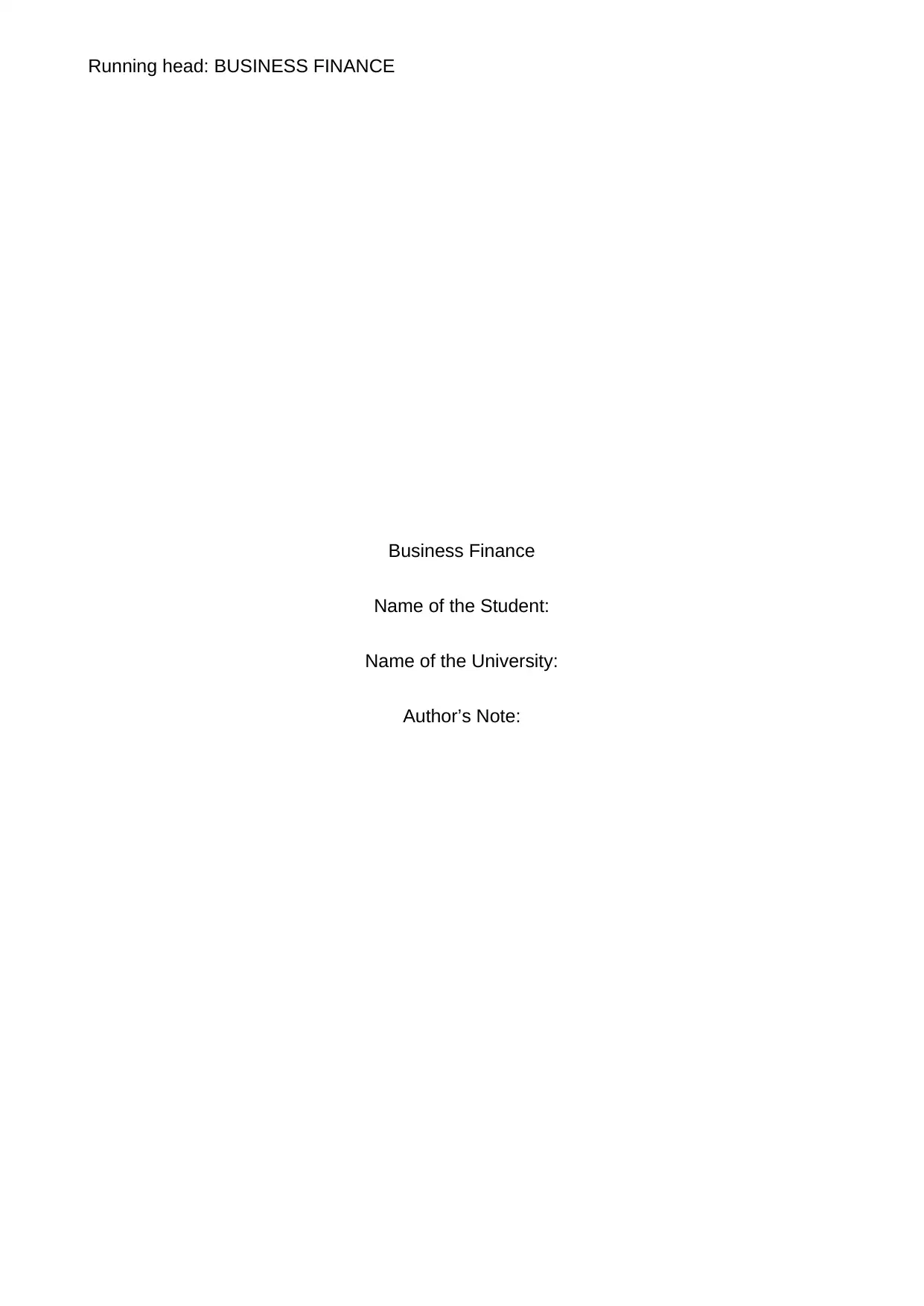
Running head: BUSINESS FINANCE
Business Finance
Name of the Student:
Name of the University:
Author’s Note:
Business Finance
Name of the Student:
Name of the University:
Author’s Note:
Paraphrase This Document
Need a fresh take? Get an instant paraphrase of this document with our AI Paraphraser
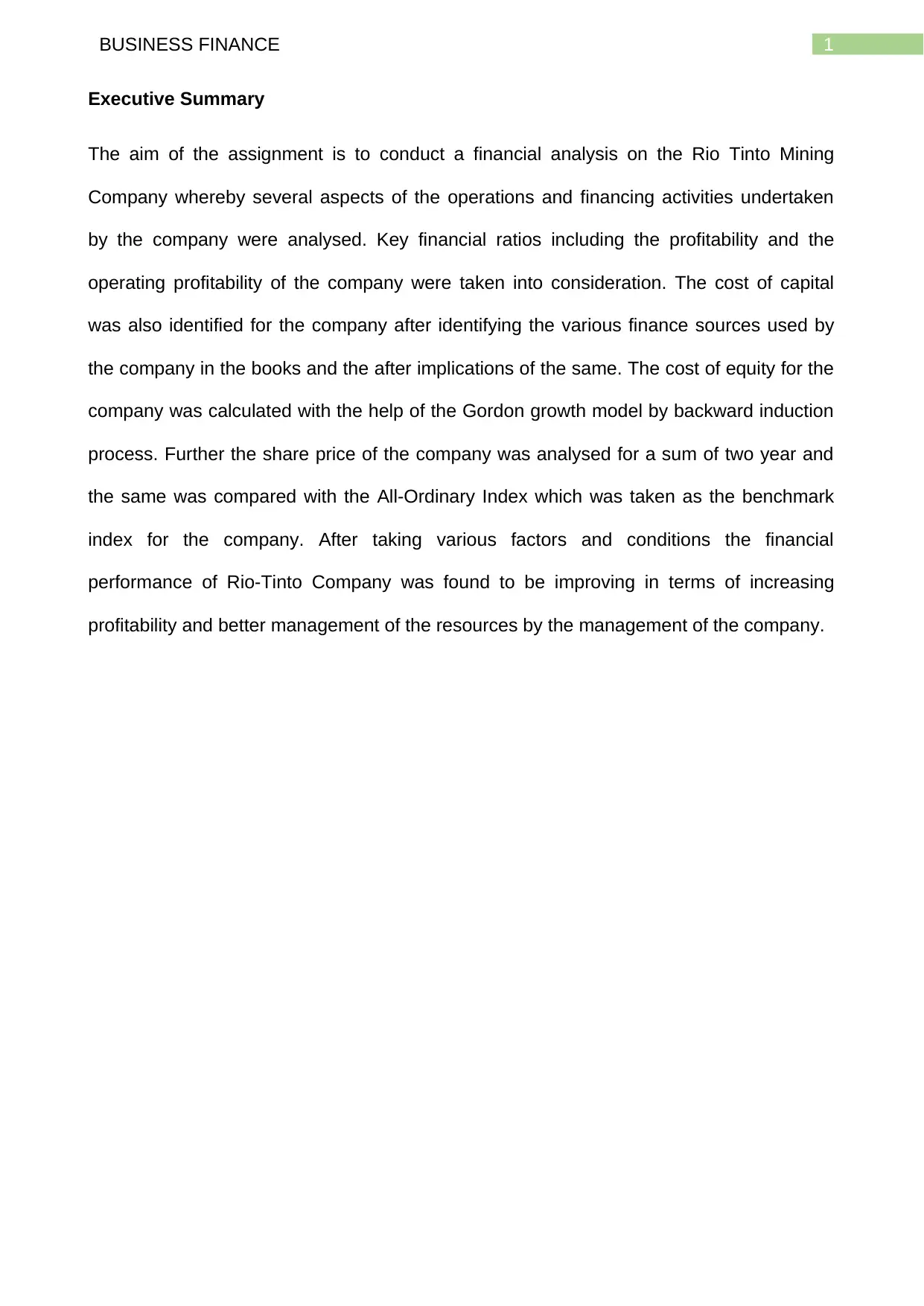
1BUSINESS FINANCE
Executive Summary
The aim of the assignment is to conduct a financial analysis on the Rio Tinto Mining
Company whereby several aspects of the operations and financing activities undertaken
by the company were analysed. Key financial ratios including the profitability and the
operating profitability of the company were taken into consideration. The cost of capital
was also identified for the company after identifying the various finance sources used by
the company in the books and the after implications of the same. The cost of equity for the
company was calculated with the help of the Gordon growth model by backward induction
process. Further the share price of the company was analysed for a sum of two year and
the same was compared with the All-Ordinary Index which was taken as the benchmark
index for the company. After taking various factors and conditions the financial
performance of Rio-Tinto Company was found to be improving in terms of increasing
profitability and better management of the resources by the management of the company.
Executive Summary
The aim of the assignment is to conduct a financial analysis on the Rio Tinto Mining
Company whereby several aspects of the operations and financing activities undertaken
by the company were analysed. Key financial ratios including the profitability and the
operating profitability of the company were taken into consideration. The cost of capital
was also identified for the company after identifying the various finance sources used by
the company in the books and the after implications of the same. The cost of equity for the
company was calculated with the help of the Gordon growth model by backward induction
process. Further the share price of the company was analysed for a sum of two year and
the same was compared with the All-Ordinary Index which was taken as the benchmark
index for the company. After taking various factors and conditions the financial
performance of Rio-Tinto Company was found to be improving in terms of increasing
profitability and better management of the resources by the management of the company.
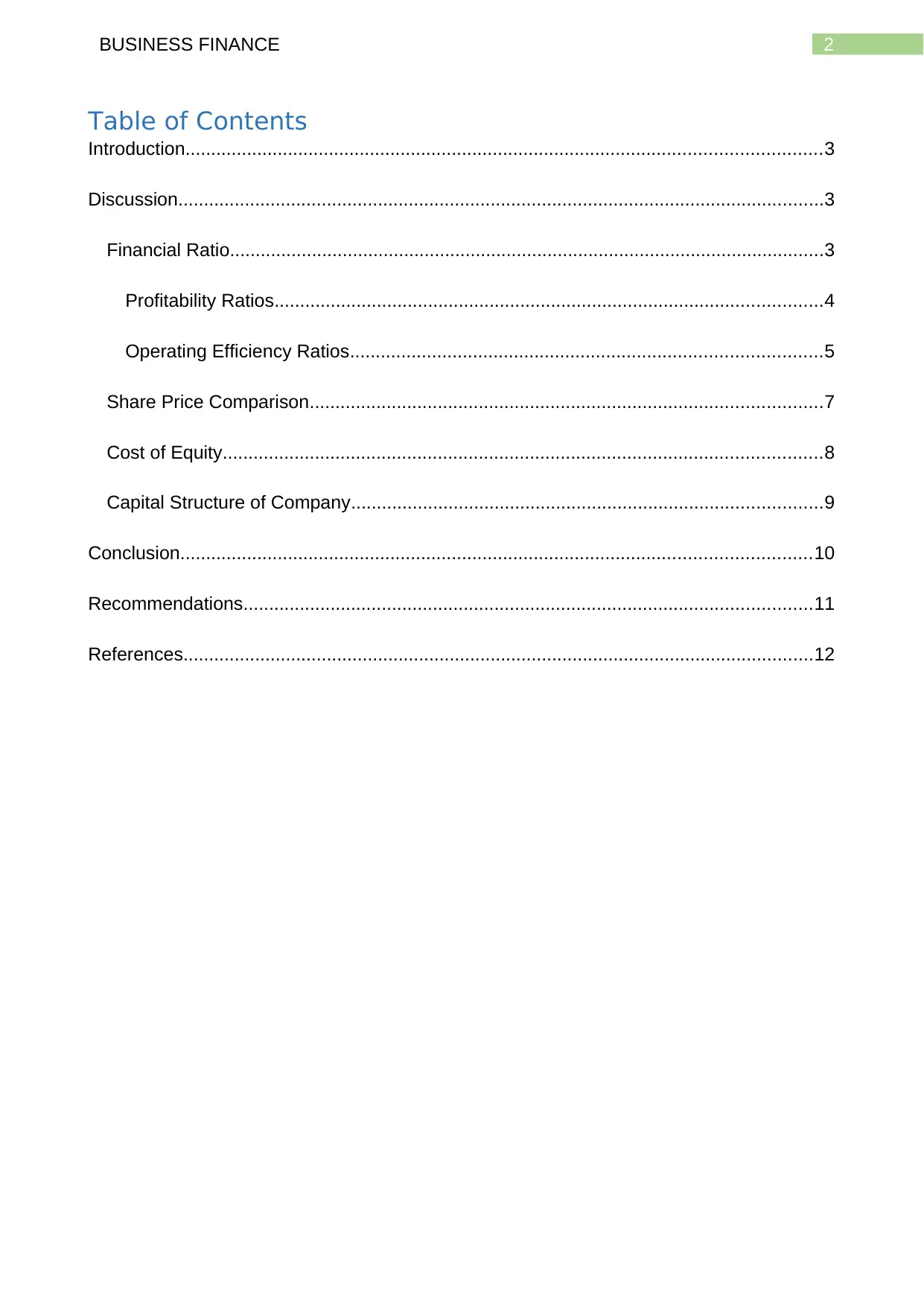
2BUSINESS FINANCE
Table of Contents
Introduction............................................................................................................................3
Discussion..............................................................................................................................3
Financial Ratio....................................................................................................................3
Profitability Ratios...........................................................................................................4
Operating Efficiency Ratios............................................................................................5
Share Price Comparison....................................................................................................7
Cost of Equity.....................................................................................................................8
Capital Structure of Company............................................................................................9
Conclusion...........................................................................................................................10
Recommendations...............................................................................................................11
References...........................................................................................................................12
Table of Contents
Introduction............................................................................................................................3
Discussion..............................................................................................................................3
Financial Ratio....................................................................................................................3
Profitability Ratios...........................................................................................................4
Operating Efficiency Ratios............................................................................................5
Share Price Comparison....................................................................................................7
Cost of Equity.....................................................................................................................8
Capital Structure of Company............................................................................................9
Conclusion...........................................................................................................................10
Recommendations...............................................................................................................11
References...........................................................................................................................12
⊘ This is a preview!⊘
Do you want full access?
Subscribe today to unlock all pages.

Trusted by 1+ million students worldwide
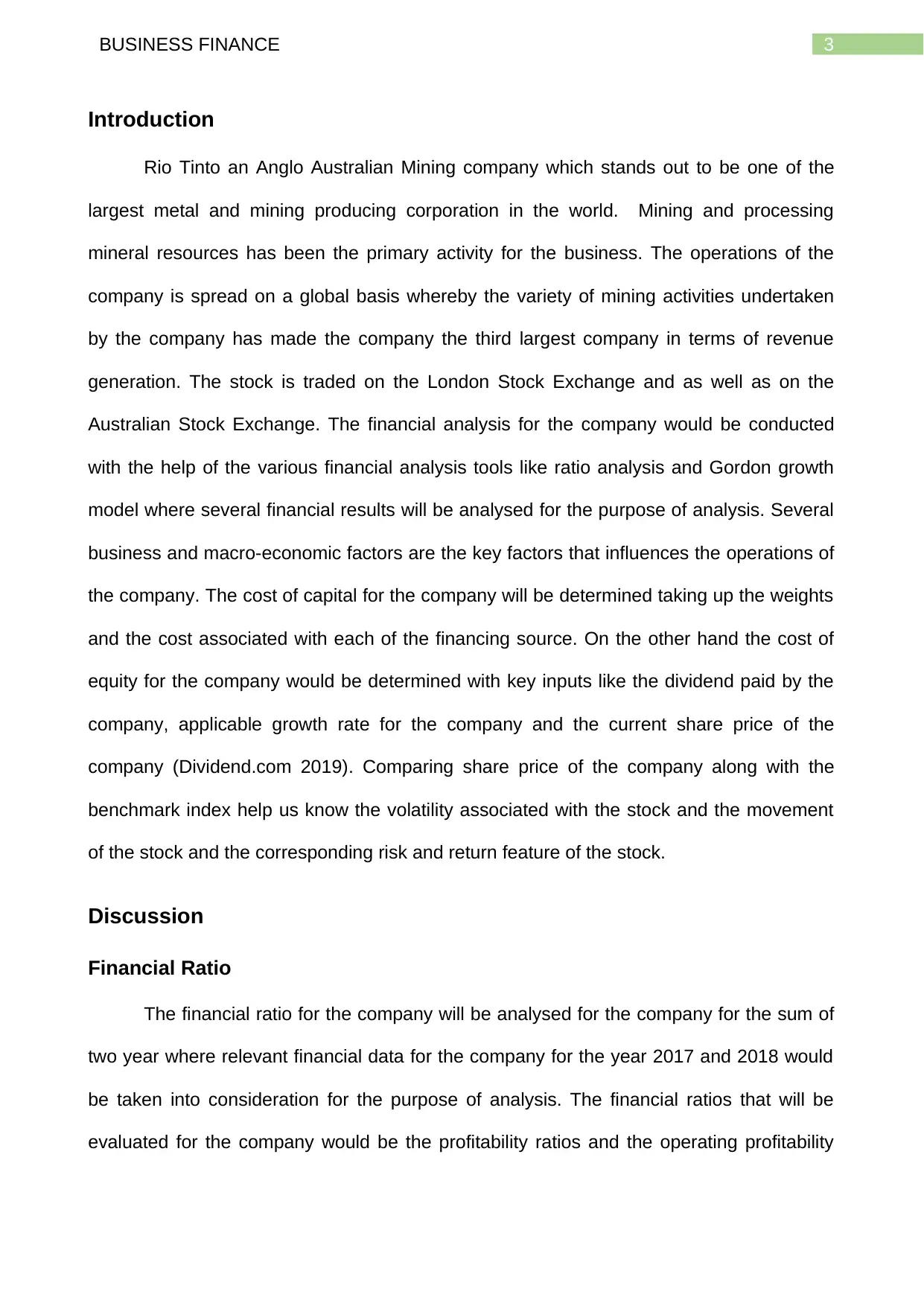
3BUSINESS FINANCE
Introduction
Rio Tinto an Anglo Australian Mining company which stands out to be one of the
largest metal and mining producing corporation in the world. Mining and processing
mineral resources has been the primary activity for the business. The operations of the
company is spread on a global basis whereby the variety of mining activities undertaken
by the company has made the company the third largest company in terms of revenue
generation. The stock is traded on the London Stock Exchange and as well as on the
Australian Stock Exchange. The financial analysis for the company would be conducted
with the help of the various financial analysis tools like ratio analysis and Gordon growth
model where several financial results will be analysed for the purpose of analysis. Several
business and macro-economic factors are the key factors that influences the operations of
the company. The cost of capital for the company will be determined taking up the weights
and the cost associated with each of the financing source. On the other hand the cost of
equity for the company would be determined with key inputs like the dividend paid by the
company, applicable growth rate for the company and the current share price of the
company (Dividend.com 2019). Comparing share price of the company along with the
benchmark index help us know the volatility associated with the stock and the movement
of the stock and the corresponding risk and return feature of the stock.
Discussion
Financial Ratio
The financial ratio for the company will be analysed for the company for the sum of
two year where relevant financial data for the company for the year 2017 and 2018 would
be taken into consideration for the purpose of analysis. The financial ratios that will be
evaluated for the company would be the profitability ratios and the operating profitability
Introduction
Rio Tinto an Anglo Australian Mining company which stands out to be one of the
largest metal and mining producing corporation in the world. Mining and processing
mineral resources has been the primary activity for the business. The operations of the
company is spread on a global basis whereby the variety of mining activities undertaken
by the company has made the company the third largest company in terms of revenue
generation. The stock is traded on the London Stock Exchange and as well as on the
Australian Stock Exchange. The financial analysis for the company would be conducted
with the help of the various financial analysis tools like ratio analysis and Gordon growth
model where several financial results will be analysed for the purpose of analysis. Several
business and macro-economic factors are the key factors that influences the operations of
the company. The cost of capital for the company will be determined taking up the weights
and the cost associated with each of the financing source. On the other hand the cost of
equity for the company would be determined with key inputs like the dividend paid by the
company, applicable growth rate for the company and the current share price of the
company (Dividend.com 2019). Comparing share price of the company along with the
benchmark index help us know the volatility associated with the stock and the movement
of the stock and the corresponding risk and return feature of the stock.
Discussion
Financial Ratio
The financial ratio for the company will be analysed for the company for the sum of
two year where relevant financial data for the company for the year 2017 and 2018 would
be taken into consideration for the purpose of analysis. The financial ratios that will be
evaluated for the company would be the profitability ratios and the operating profitability
Paraphrase This Document
Need a fresh take? Get an instant paraphrase of this document with our AI Paraphraser
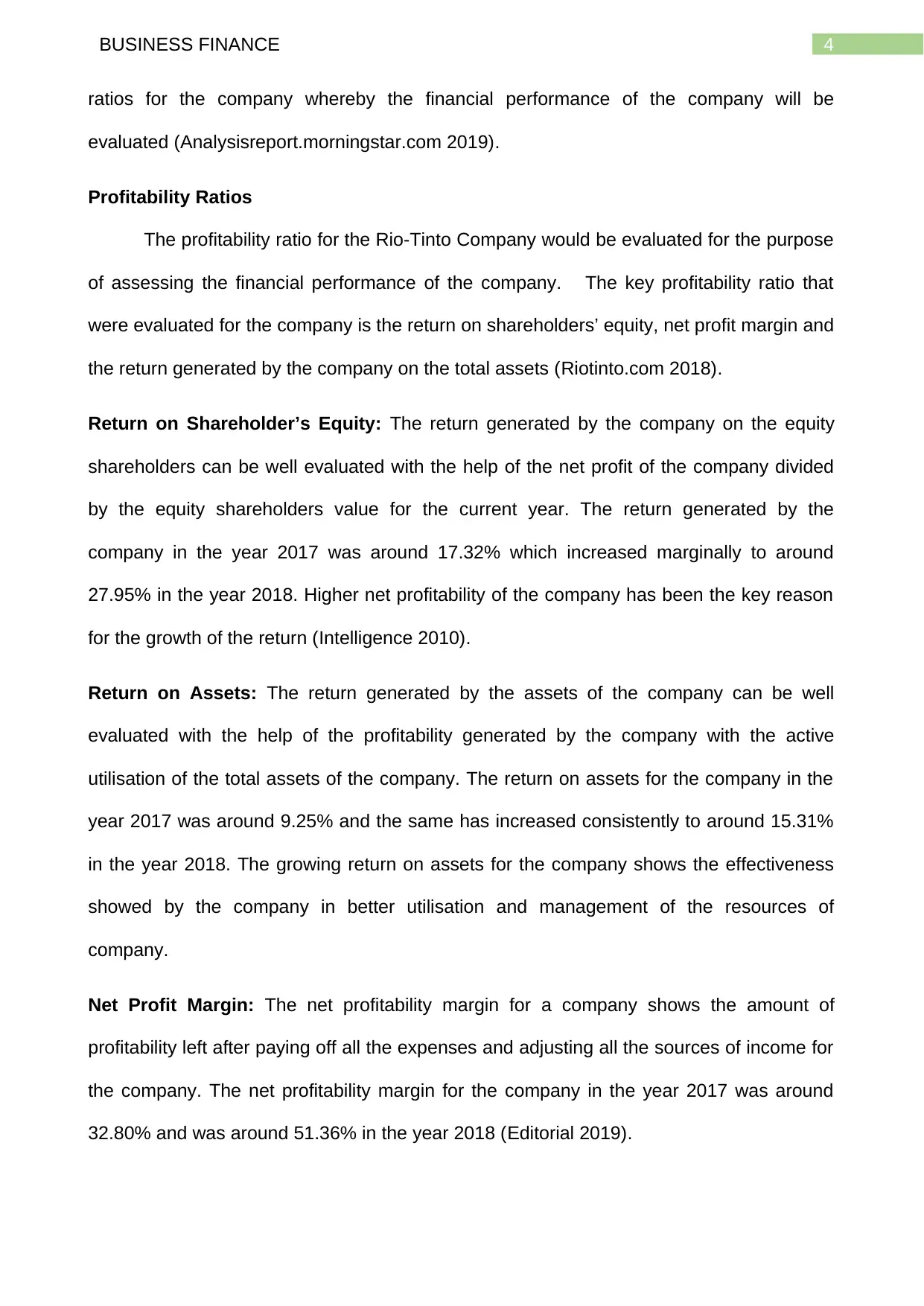
4BUSINESS FINANCE
ratios for the company whereby the financial performance of the company will be
evaluated (Analysisreport.morningstar.com 2019).
Profitability Ratios
The profitability ratio for the Rio-Tinto Company would be evaluated for the purpose
of assessing the financial performance of the company. The key profitability ratio that
were evaluated for the company is the return on shareholders’ equity, net profit margin and
the return generated by the company on the total assets (Riotinto.com 2018).
Return on Shareholder’s Equity: The return generated by the company on the equity
shareholders can be well evaluated with the help of the net profit of the company divided
by the equity shareholders value for the current year. The return generated by the
company in the year 2017 was around 17.32% which increased marginally to around
27.95% in the year 2018. Higher net profitability of the company has been the key reason
for the growth of the return (Intelligence 2010).
Return on Assets: The return generated by the assets of the company can be well
evaluated with the help of the profitability generated by the company with the active
utilisation of the total assets of the company. The return on assets for the company in the
year 2017 was around 9.25% and the same has increased consistently to around 15.31%
in the year 2018. The growing return on assets for the company shows the effectiveness
showed by the company in better utilisation and management of the resources of
company.
Net Profit Margin: The net profitability margin for a company shows the amount of
profitability left after paying off all the expenses and adjusting all the sources of income for
the company. The net profitability margin for the company in the year 2017 was around
32.80% and was around 51.36% in the year 2018 (Editorial 2019).
ratios for the company whereby the financial performance of the company will be
evaluated (Analysisreport.morningstar.com 2019).
Profitability Ratios
The profitability ratio for the Rio-Tinto Company would be evaluated for the purpose
of assessing the financial performance of the company. The key profitability ratio that
were evaluated for the company is the return on shareholders’ equity, net profit margin and
the return generated by the company on the total assets (Riotinto.com 2018).
Return on Shareholder’s Equity: The return generated by the company on the equity
shareholders can be well evaluated with the help of the net profit of the company divided
by the equity shareholders value for the current year. The return generated by the
company in the year 2017 was around 17.32% which increased marginally to around
27.95% in the year 2018. Higher net profitability of the company has been the key reason
for the growth of the return (Intelligence 2010).
Return on Assets: The return generated by the assets of the company can be well
evaluated with the help of the profitability generated by the company with the active
utilisation of the total assets of the company. The return on assets for the company in the
year 2017 was around 9.25% and the same has increased consistently to around 15.31%
in the year 2018. The growing return on assets for the company shows the effectiveness
showed by the company in better utilisation and management of the resources of
company.
Net Profit Margin: The net profitability margin for a company shows the amount of
profitability left after paying off all the expenses and adjusting all the sources of income for
the company. The net profitability margin for the company in the year 2017 was around
32.80% and was around 51.36% in the year 2018 (Editorial 2019).
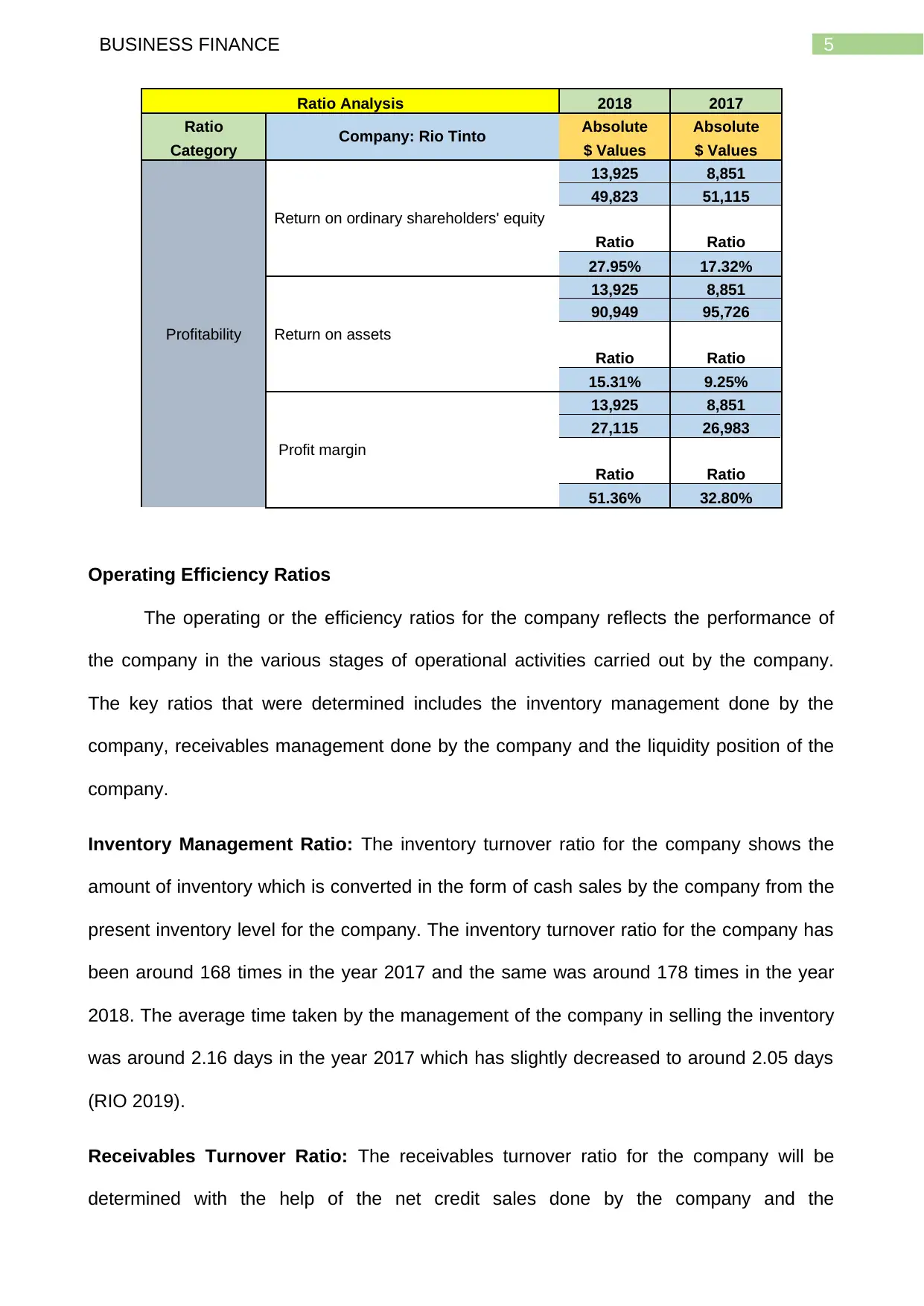
5BUSINESS FINANCE
Ratio Analysis 2018 2017
Ratio Company: Rio Tinto Absolute Absolute
Category $ Values $ Values
Profitability
Return on ordinary shareholders' equity
13,925 8,851
49,823 51,115
Ratio Ratio
27.95% 17.32%
Return on assets
13,925 8,851
90,949 95,726
Ratio Ratio
15.31% 9.25%
Profit margin
13,925 8,851
27,115 26,983
Ratio Ratio
51.36% 32.80%
Operating Efficiency Ratios
The operating or the efficiency ratios for the company reflects the performance of
the company in the various stages of operational activities carried out by the company.
The key ratios that were determined includes the inventory management done by the
company, receivables management done by the company and the liquidity position of the
company.
Inventory Management Ratio: The inventory turnover ratio for the company shows the
amount of inventory which is converted in the form of cash sales by the company from the
present inventory level for the company. The inventory turnover ratio for the company has
been around 168 times in the year 2017 and the same was around 178 times in the year
2018. The average time taken by the management of the company in selling the inventory
was around 2.16 days in the year 2017 which has slightly decreased to around 2.05 days
(RIO 2019).
Receivables Turnover Ratio: The receivables turnover ratio for the company will be
determined with the help of the net credit sales done by the company and the
Ratio Analysis 2018 2017
Ratio Company: Rio Tinto Absolute Absolute
Category $ Values $ Values
Profitability
Return on ordinary shareholders' equity
13,925 8,851
49,823 51,115
Ratio Ratio
27.95% 17.32%
Return on assets
13,925 8,851
90,949 95,726
Ratio Ratio
15.31% 9.25%
Profit margin
13,925 8,851
27,115 26,983
Ratio Ratio
51.36% 32.80%
Operating Efficiency Ratios
The operating or the efficiency ratios for the company reflects the performance of
the company in the various stages of operational activities carried out by the company.
The key ratios that were determined includes the inventory management done by the
company, receivables management done by the company and the liquidity position of the
company.
Inventory Management Ratio: The inventory turnover ratio for the company shows the
amount of inventory which is converted in the form of cash sales by the company from the
present inventory level for the company. The inventory turnover ratio for the company has
been around 168 times in the year 2017 and the same was around 178 times in the year
2018. The average time taken by the management of the company in selling the inventory
was around 2.16 days in the year 2017 which has slightly decreased to around 2.05 days
(RIO 2019).
Receivables Turnover Ratio: The receivables turnover ratio for the company will be
determined with the help of the net credit sales done by the company and the
⊘ This is a preview!⊘
Do you want full access?
Subscribe today to unlock all pages.

Trusted by 1+ million students worldwide

6BUSINESS FINANCE
corresponding net receivables of the company. The net receivables in days for the
company was around 23 days in the year 2017 and was around 21 days in the year 2018.
The reduction in the receivables days for the company shows the efficiency of the
management of the company in managing the credit sales or receivables of the company
(Analytics 2019).
Liquidity Ratio: The liquidity ratio for the company shows the ability of the company in
meeting the current obligations of the company. The liquidity position of the company can
be well evaluated with the help of current ratio of the company. The current ratio for the
company in the year 2017 was around 1.66 times that increased to around 1.91 times in
the year 2018. The increase in the current ratio for the company shows the wide coverage
of the current assets of the company in correspondence to the current liabilities of the
company. The appropriate liquid ratio that should be maintained by the company is
around 2 times which is well achievable by the company.
Ratio Analysis 2018 2017
Ratio Company: Rio Tinto Absolute Absolute
Category $ Values $ Values
Liquidity Current ratio
20,168 18,678
10,571 11,225
Ratio Ratio
1.91 1.66
Activity
Inventory turnover
27,115 26,983
152 160
Ratio Ratio
178.39 168.64
Average days in inventory
365 365
178.39 168.64
Ratio Ratio
2.05 2.16
27,115 26,983
1,585 1,724
Receivables turnover
Ratio Ratio
17.11 15.65
Average days receivables 365 365
17.11 15.65
Ratio Ratio
corresponding net receivables of the company. The net receivables in days for the
company was around 23 days in the year 2017 and was around 21 days in the year 2018.
The reduction in the receivables days for the company shows the efficiency of the
management of the company in managing the credit sales or receivables of the company
(Analytics 2019).
Liquidity Ratio: The liquidity ratio for the company shows the ability of the company in
meeting the current obligations of the company. The liquidity position of the company can
be well evaluated with the help of current ratio of the company. The current ratio for the
company in the year 2017 was around 1.66 times that increased to around 1.91 times in
the year 2018. The increase in the current ratio for the company shows the wide coverage
of the current assets of the company in correspondence to the current liabilities of the
company. The appropriate liquid ratio that should be maintained by the company is
around 2 times which is well achievable by the company.
Ratio Analysis 2018 2017
Ratio Company: Rio Tinto Absolute Absolute
Category $ Values $ Values
Liquidity Current ratio
20,168 18,678
10,571 11,225
Ratio Ratio
1.91 1.66
Activity
Inventory turnover
27,115 26,983
152 160
Ratio Ratio
178.39 168.64
Average days in inventory
365 365
178.39 168.64
Ratio Ratio
2.05 2.16
27,115 26,983
1,585 1,724
Receivables turnover
Ratio Ratio
17.11 15.65
Average days receivables 365 365
17.11 15.65
Ratio Ratio
Paraphrase This Document
Need a fresh take? Get an instant paraphrase of this document with our AI Paraphraser
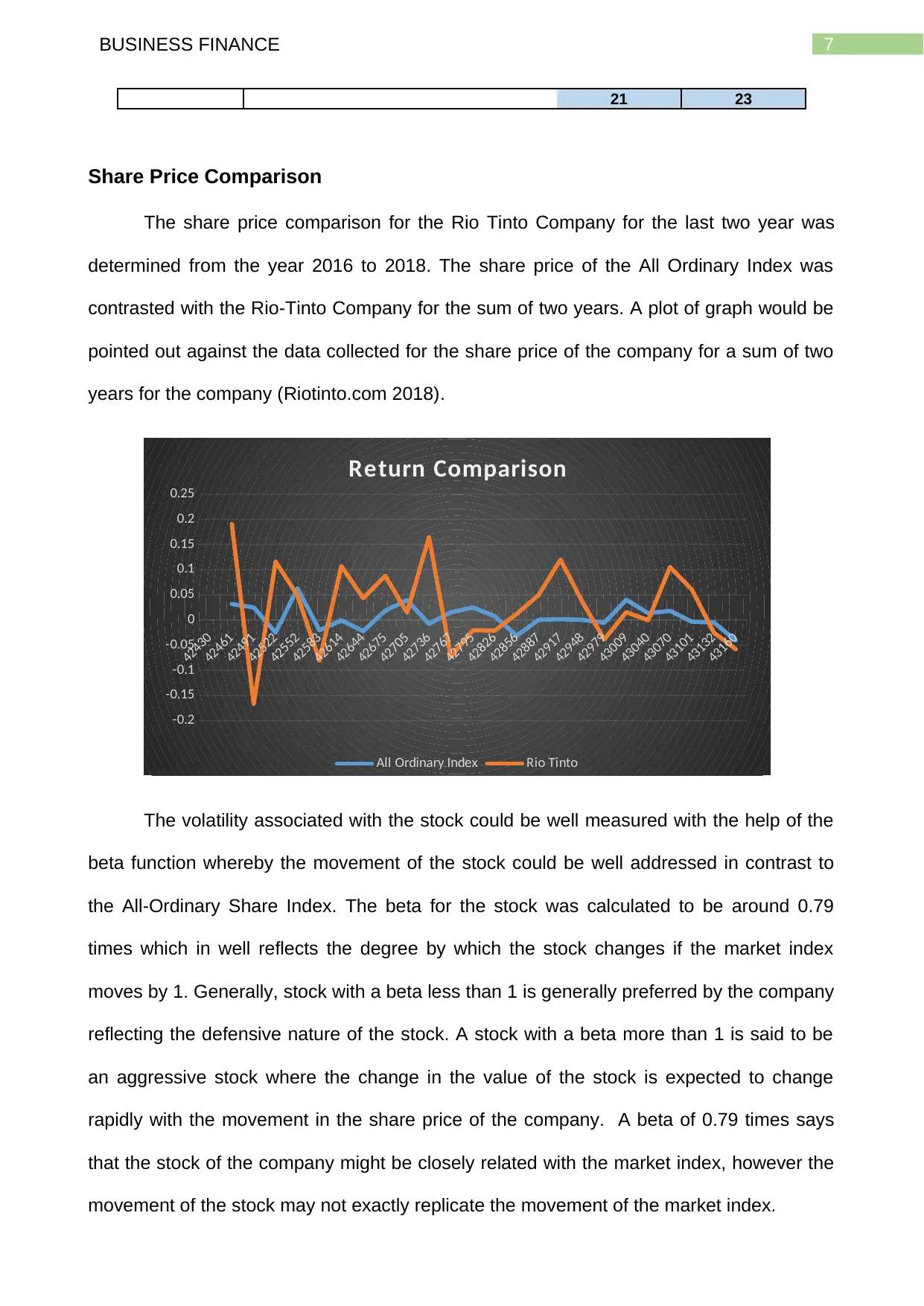
7BUSINESS FINANCE
21 23
Share Price Comparison
The share price comparison for the Rio Tinto Company for the last two year was
determined from the year 2016 to 2018. The share price of the All Ordinary Index was
contrasted with the Rio-Tinto Company for the sum of two years. A plot of graph would be
pointed out against the data collected for the share price of the company for a sum of two
years for the company (Riotinto.com 2018).
42430
42461
42491
42522
42552
42583
42614
42644
42675
42705
42736
42767
42795
42826
42856
42887
42917
42948
42979
43009
43040
43070
43101
43132
43160
-0.2
-0.15
-0.1
-0.05
0
0.05
0.1
0.15
0.2
0.25
Return Comparison
All Ordinary Index Rio Tinto
The volatility associated with the stock could be well measured with the help of the
beta function whereby the movement of the stock could be well addressed in contrast to
the All-Ordinary Share Index. The beta for the stock was calculated to be around 0.79
times which in well reflects the degree by which the stock changes if the market index
moves by 1. Generally, stock with a beta less than 1 is generally preferred by the company
reflecting the defensive nature of the stock. A stock with a beta more than 1 is said to be
an aggressive stock where the change in the value of the stock is expected to change
rapidly with the movement in the share price of the company. A beta of 0.79 times says
that the stock of the company might be closely related with the market index, however the
movement of the stock may not exactly replicate the movement of the market index.
21 23
Share Price Comparison
The share price comparison for the Rio Tinto Company for the last two year was
determined from the year 2016 to 2018. The share price of the All Ordinary Index was
contrasted with the Rio-Tinto Company for the sum of two years. A plot of graph would be
pointed out against the data collected for the share price of the company for a sum of two
years for the company (Riotinto.com 2018).
42430
42461
42491
42522
42552
42583
42614
42644
42675
42705
42736
42767
42795
42826
42856
42887
42917
42948
42979
43009
43040
43070
43101
43132
43160
-0.2
-0.15
-0.1
-0.05
0
0.05
0.1
0.15
0.2
0.25
Return Comparison
All Ordinary Index Rio Tinto
The volatility associated with the stock could be well measured with the help of the
beta function whereby the movement of the stock could be well addressed in contrast to
the All-Ordinary Share Index. The beta for the stock was calculated to be around 0.79
times which in well reflects the degree by which the stock changes if the market index
moves by 1. Generally, stock with a beta less than 1 is generally preferred by the company
reflecting the defensive nature of the stock. A stock with a beta more than 1 is said to be
an aggressive stock where the change in the value of the stock is expected to change
rapidly with the movement in the share price of the company. A beta of 0.79 times says
that the stock of the company might be closely related with the market index, however the
movement of the stock may not exactly replicate the movement of the market index.

8BUSINESS FINANCE
The possible reason which might affect the share price of the company can be
because of the change in the macro-economic condition like the inflation rate, GDP growth
rate and the global demand and supply of mineral resources operated by the company.
The changing global market in terms of the demand and increasing competition in the
international market has been the key reason for movement in the share price of the
company. Growing revenue and consistent rise in the profitability of the company on a
year to year basis also has been the key reason behind the massive increase in the share
price of the company. The return generated by the share price in this two-year was around
30% and at the same time the market generated 7% return.
Cost of Equity
The cost of equity for the company was calculated with the help of the Dividend
Growth Model where the cost of equity for the company would be determined with key
inputs like the dividend paid by the company, applicable growth rate for the company and
the current share price of the company (Coverage et al. 2019). The current dividend of the
company will be multiplied with the applicable growth rate and the constant growth rate of
the dividend will be taken at 4%. The Po or the share price of the company was taken as
of 31st March 2018. The cost of equity for the Rio-Tinto Share was determined to be
around 9.71% for the company (Asx.com.au. 2019).
2/1/2016
4/1/2016
6/1/2016
8/1/2016
10/1/2016
12/1/2016
2/1/2017
4/1/2017
6/1/2017
8/1/2017
10/1/2017
12/1/2017
2/1/2018
4600
5000
5400
5800
6200
All Ordinary Share Index
2/1/2016
4/1/2016
6/1/2016
8/1/2016
10/1/2016
12/1/2016
2/1/2017
4/1/2017
6/1/2017
8/1/2017
10/1/2017
12/1/2017
2/1/2018
0
20
40
60
80
Rio Tinto Share Price
The possible reason which might affect the share price of the company can be
because of the change in the macro-economic condition like the inflation rate, GDP growth
rate and the global demand and supply of mineral resources operated by the company.
The changing global market in terms of the demand and increasing competition in the
international market has been the key reason for movement in the share price of the
company. Growing revenue and consistent rise in the profitability of the company on a
year to year basis also has been the key reason behind the massive increase in the share
price of the company. The return generated by the share price in this two-year was around
30% and at the same time the market generated 7% return.
Cost of Equity
The cost of equity for the company was calculated with the help of the Dividend
Growth Model where the cost of equity for the company would be determined with key
inputs like the dividend paid by the company, applicable growth rate for the company and
the current share price of the company (Coverage et al. 2019). The current dividend of the
company will be multiplied with the applicable growth rate and the constant growth rate of
the dividend will be taken at 4%. The Po or the share price of the company was taken as
of 31st March 2018. The cost of equity for the Rio-Tinto Share was determined to be
around 9.71% for the company (Asx.com.au. 2019).
2/1/2016
4/1/2016
6/1/2016
8/1/2016
10/1/2016
12/1/2016
2/1/2017
4/1/2017
6/1/2017
8/1/2017
10/1/2017
12/1/2017
2/1/2018
4600
5000
5400
5800
6200
All Ordinary Share Index
2/1/2016
4/1/2016
6/1/2016
8/1/2016
10/1/2016
12/1/2016
2/1/2017
4/1/2017
6/1/2017
8/1/2017
10/1/2017
12/1/2017
2/1/2018
0
20
40
60
80
Rio Tinto Share Price
⊘ This is a preview!⊘
Do you want full access?
Subscribe today to unlock all pages.

Trusted by 1+ million students worldwide
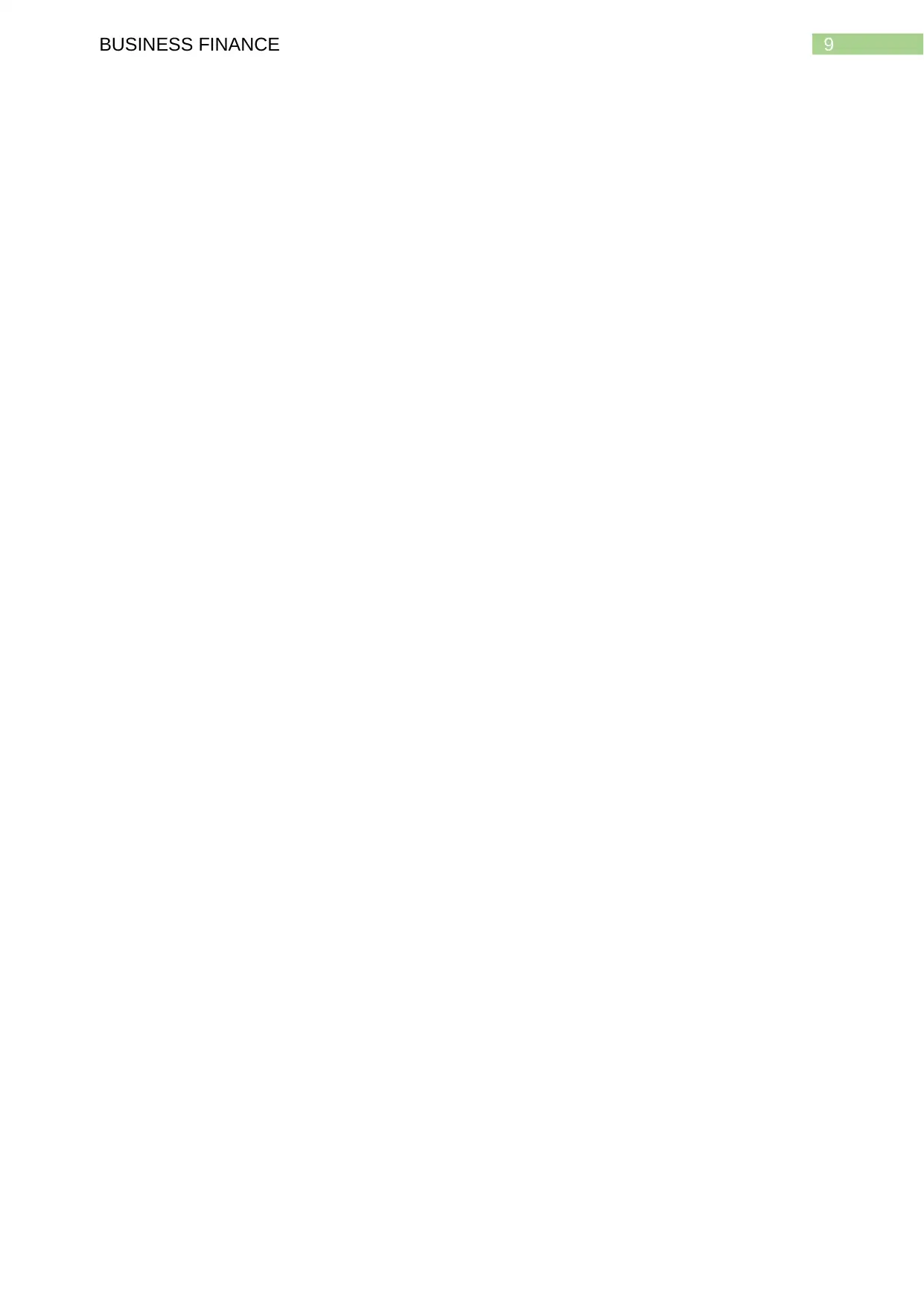
9BUSINESS FINANCE
Paraphrase This Document
Need a fresh take? Get an instant paraphrase of this document with our AI Paraphraser
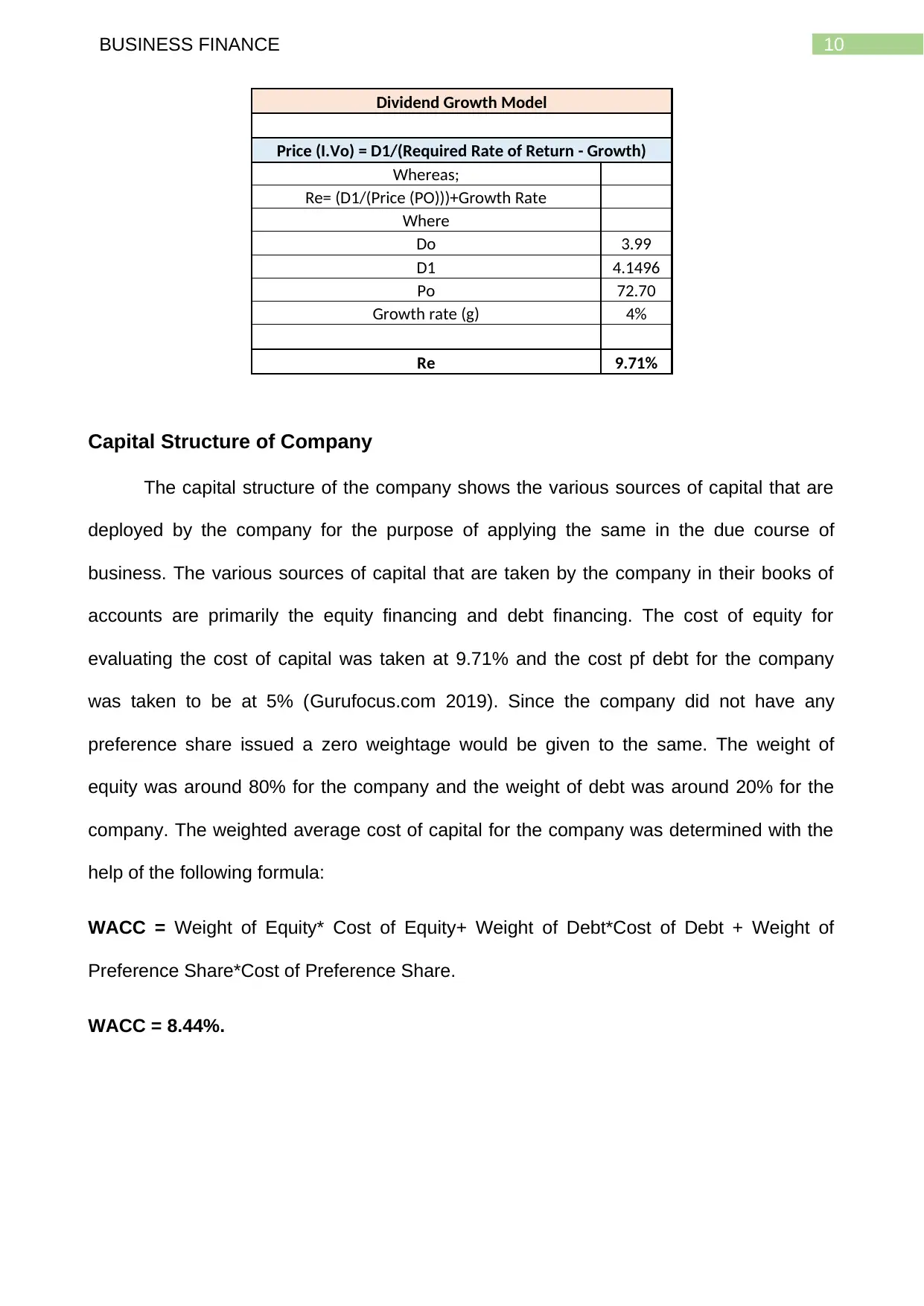
10BUSINESS FINANCE
Dividend Growth Model
Price (I.Vo) = D1/(Required Rate of Return - Growth)
Whereas;
Re= (D1/(Price (PO)))+Growth Rate
Where
Do 3.99
D1 4.1496
Po 72.70
Growth rate (g) 4%
Re 9.71%
Capital Structure of Company
The capital structure of the company shows the various sources of capital that are
deployed by the company for the purpose of applying the same in the due course of
business. The various sources of capital that are taken by the company in their books of
accounts are primarily the equity financing and debt financing. The cost of equity for
evaluating the cost of capital was taken at 9.71% and the cost pf debt for the company
was taken to be at 5% (Gurufocus.com 2019). Since the company did not have any
preference share issued a zero weightage would be given to the same. The weight of
equity was around 80% for the company and the weight of debt was around 20% for the
company. The weighted average cost of capital for the company was determined with the
help of the following formula:
WACC = Weight of Equity* Cost of Equity+ Weight of Debt*Cost of Debt + Weight of
Preference Share*Cost of Preference Share.
WACC = 8.44%.
Dividend Growth Model
Price (I.Vo) = D1/(Required Rate of Return - Growth)
Whereas;
Re= (D1/(Price (PO)))+Growth Rate
Where
Do 3.99
D1 4.1496
Po 72.70
Growth rate (g) 4%
Re 9.71%
Capital Structure of Company
The capital structure of the company shows the various sources of capital that are
deployed by the company for the purpose of applying the same in the due course of
business. The various sources of capital that are taken by the company in their books of
accounts are primarily the equity financing and debt financing. The cost of equity for
evaluating the cost of capital was taken at 9.71% and the cost pf debt for the company
was taken to be at 5% (Gurufocus.com 2019). Since the company did not have any
preference share issued a zero weightage would be given to the same. The weight of
equity was around 80% for the company and the weight of debt was around 20% for the
company. The weighted average cost of capital for the company was determined with the
help of the following formula:
WACC = Weight of Equity* Cost of Equity+ Weight of Debt*Cost of Debt + Weight of
Preference Share*Cost of Preference Share.
WACC = 8.44%.
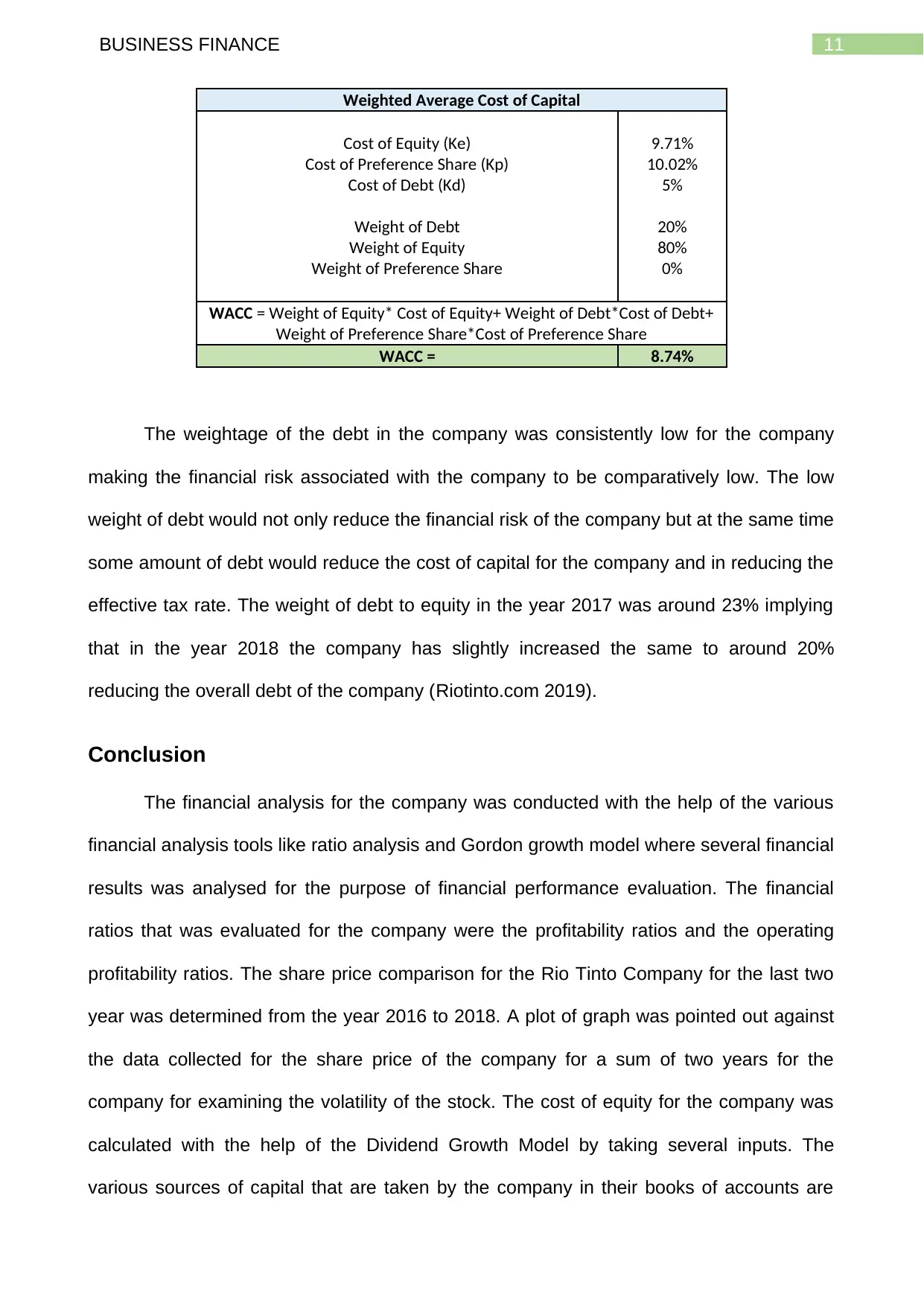
11BUSINESS FINANCE
Weighted Average Cost of Capital
Cost of Equity (Ke) 9.71%
Cost of Preference Share (Kp) 10.02%
Cost of Debt (Kd) 5%
Weight of Debt 20%
Weight of Equity 80%
Weight of Preference Share 0%
WACC = Weight of Equity* Cost of Equity+ Weight of Debt*Cost of Debt+
Weight of Preference Share*Cost of Preference Share
WACC = 8.74%
The weightage of the debt in the company was consistently low for the company
making the financial risk associated with the company to be comparatively low. The low
weight of debt would not only reduce the financial risk of the company but at the same time
some amount of debt would reduce the cost of capital for the company and in reducing the
effective tax rate. The weight of debt to equity in the year 2017 was around 23% implying
that in the year 2018 the company has slightly increased the same to around 20%
reducing the overall debt of the company (Riotinto.com 2019).
Conclusion
The financial analysis for the company was conducted with the help of the various
financial analysis tools like ratio analysis and Gordon growth model where several financial
results was analysed for the purpose of financial performance evaluation. The financial
ratios that was evaluated for the company were the profitability ratios and the operating
profitability ratios. The share price comparison for the Rio Tinto Company for the last two
year was determined from the year 2016 to 2018. A plot of graph was pointed out against
the data collected for the share price of the company for a sum of two years for the
company for examining the volatility of the stock. The cost of equity for the company was
calculated with the help of the Dividend Growth Model by taking several inputs. The
various sources of capital that are taken by the company in their books of accounts are
Weighted Average Cost of Capital
Cost of Equity (Ke) 9.71%
Cost of Preference Share (Kp) 10.02%
Cost of Debt (Kd) 5%
Weight of Debt 20%
Weight of Equity 80%
Weight of Preference Share 0%
WACC = Weight of Equity* Cost of Equity+ Weight of Debt*Cost of Debt+
Weight of Preference Share*Cost of Preference Share
WACC = 8.74%
The weightage of the debt in the company was consistently low for the company
making the financial risk associated with the company to be comparatively low. The low
weight of debt would not only reduce the financial risk of the company but at the same time
some amount of debt would reduce the cost of capital for the company and in reducing the
effective tax rate. The weight of debt to equity in the year 2017 was around 23% implying
that in the year 2018 the company has slightly increased the same to around 20%
reducing the overall debt of the company (Riotinto.com 2019).
Conclusion
The financial analysis for the company was conducted with the help of the various
financial analysis tools like ratio analysis and Gordon growth model where several financial
results was analysed for the purpose of financial performance evaluation. The financial
ratios that was evaluated for the company were the profitability ratios and the operating
profitability ratios. The share price comparison for the Rio Tinto Company for the last two
year was determined from the year 2016 to 2018. A plot of graph was pointed out against
the data collected for the share price of the company for a sum of two years for the
company for examining the volatility of the stock. The cost of equity for the company was
calculated with the help of the Dividend Growth Model by taking several inputs. The
various sources of capital that are taken by the company in their books of accounts are
⊘ This is a preview!⊘
Do you want full access?
Subscribe today to unlock all pages.

Trusted by 1+ million students worldwide
1 out of 15
Related Documents
Your All-in-One AI-Powered Toolkit for Academic Success.
+13062052269
info@desklib.com
Available 24*7 on WhatsApp / Email
![[object Object]](/_next/static/media/star-bottom.7253800d.svg)
Unlock your academic potential
Copyright © 2020–2025 A2Z Services. All Rights Reserved. Developed and managed by ZUCOL.





